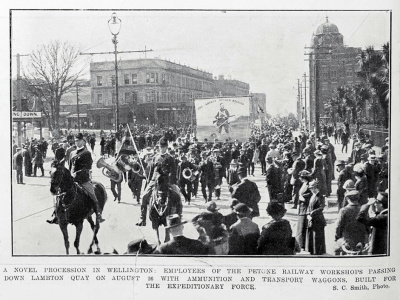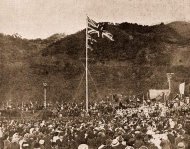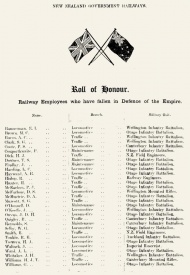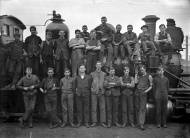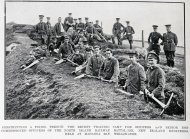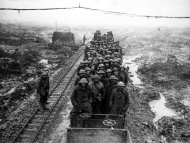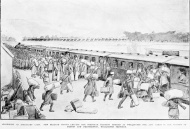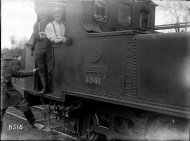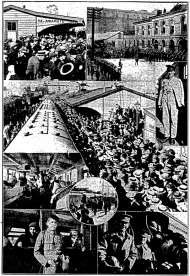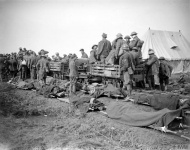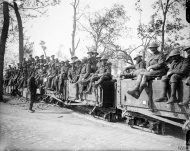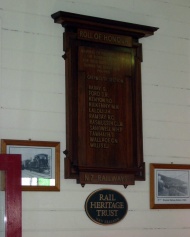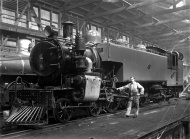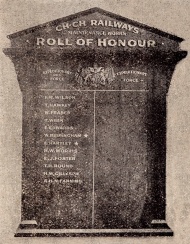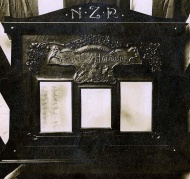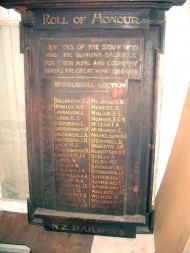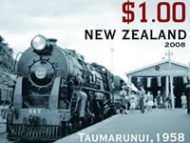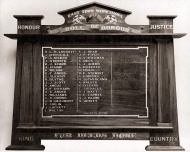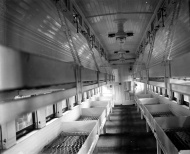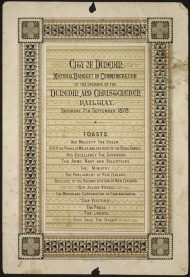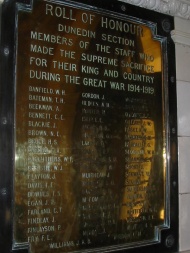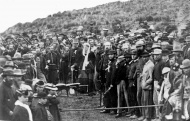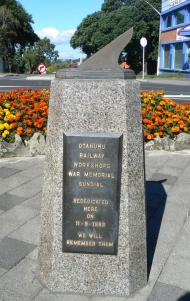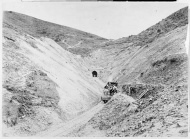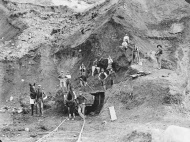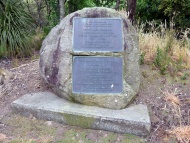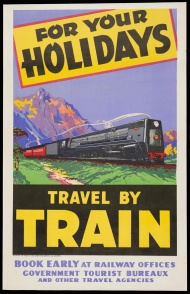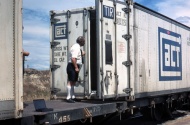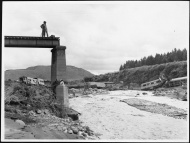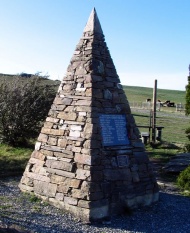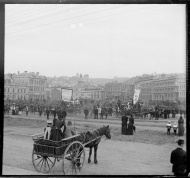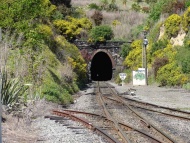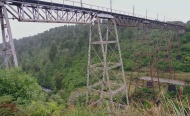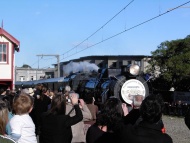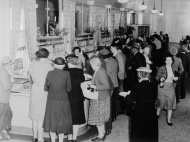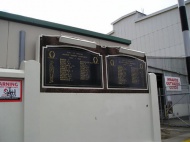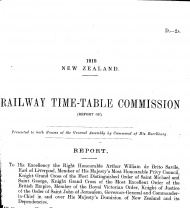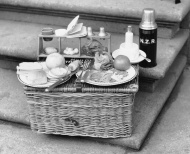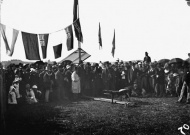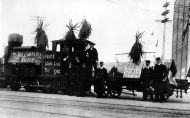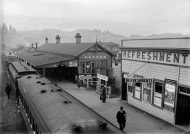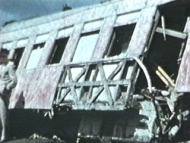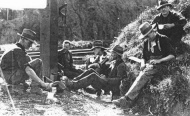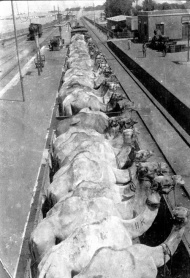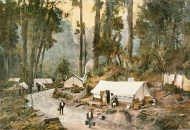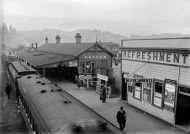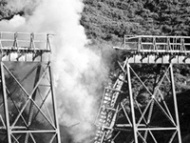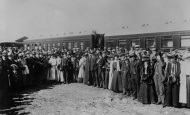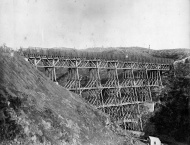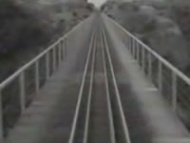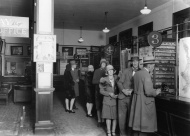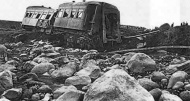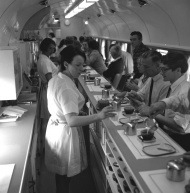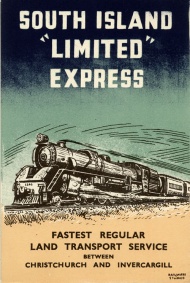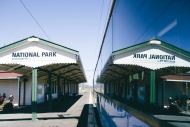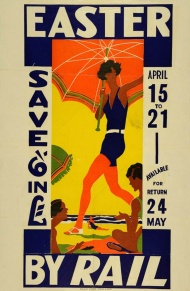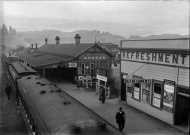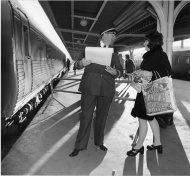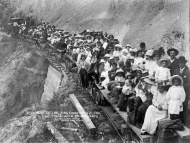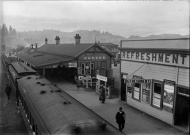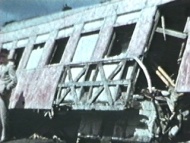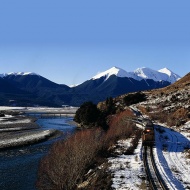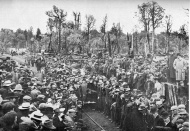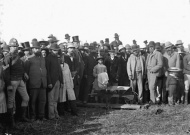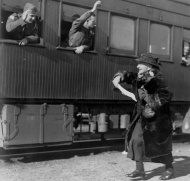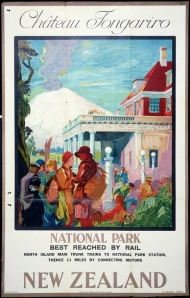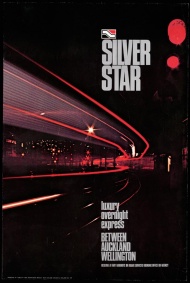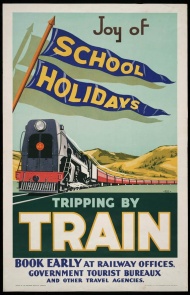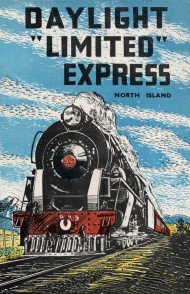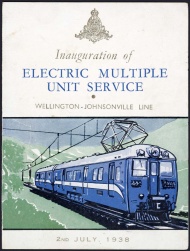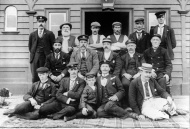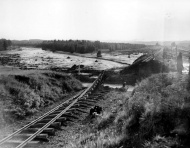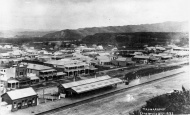Events In History
-
 25 October 1971End of the line for steam railways
25 October 1971End of the line for steam railwaysThe Christchurch–Dunedin overnight express, headed by a JA-class locomotive, ran the last scheduled steam-hauled service on New Zealand Railways (NZR), bringing to an end 108 years of regular steam rail operations in this country. Read more...
-
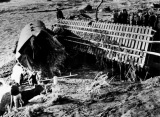 24 December 1953Tangiwai railway disaster
24 December 1953Tangiwai railway disasterThe worst railway disaster in New Zealand’s history occurred on Christmas Eve 1953, when the Wellington–Auckland night express plunged into the flooded Whangaehu River, just west of Tangiwai in the central North Island. Read more...
-
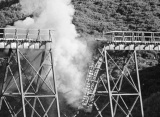 15 December 1951Belmont viaduct blown up
15 December 1951Belmont viaduct blown upThe 38-m-high railway viaduct, near Johnsonville, Wellington, was built in 1885 and had not been used since 1937. It was demolished by army engineers as a training exercise. Read more...
-
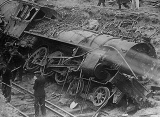 4 June 1943Rail tragedy at Hyde
4 June 1943Rail tragedy at HydeThe Cromwell–Dunedin express, travelling at speed, derailed while rounding a curve near Hyde in Central Otago. Read more...
-
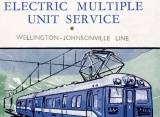 2 July 1938Electric trains come to Wellington
2 July 1938Electric trains come to WellingtonOn 2 July 1938, Minister of Railways Dan Sullivan and Wellington Mayor Thomas Hislop officially opened the electrified rail line between central Wellington and the northern suburb of Johnsonville. Read more...
-
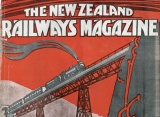 8 May 1926New Zealand Railways Magazine launched
8 May 1926New Zealand Railways Magazine launchedOriginally intended as a journal for the Railways Department’s 18,000 staff and their major customers, the New Zealand Railways Magazine evolved into a hugely popular general-interest periodical. Read more...
-
 4 August 1923Rail tunnel pierces the Southern Alps
4 August 1923Rail tunnel pierces the Southern AlpsThe opening of the 8.5-km Ōtira tunnel completed the long-planned transalpine railway between Christchurch and Greymouth. At the time, it was the longest tunnel outside the Alps and the seventh-longest in the world. Read more...
-
 24 September 1917Bere Ferrers rail accident
24 September 1917Bere Ferrers rail accidentTen New Zealand soldiers were killed when they were hit by a train at Bere Ferrers in southern England. The accident occurred as troops from the 28th Reinforcements for the NZ Expeditionary Force were being transported from Plymouth to Sling Camp on Salisbury Plain. Read more...
-
 6 November 1908Last spike completes North Island main trunk railway
6 November 1908Last spike completes North Island main trunk railwayPrime Minister Sir Joseph Ward ceremonially opened the North Island main trunk railway line by driving home a final polished silver spike at Manganuioteao, between National Park and Ohākune. Read more...
-
 20 July 1892Steam locomotive sets world speed record
20 July 1892Steam locomotive sets world speed recordThe Wellington and Manawatu Railway (WMR) Company’s locomotive No. 10 established a world speed record for the narrow 3 foot 6 inch (1067 mm) gauge, averaging 68 km per hour on a two-hour run and hitting a top speed of 103 kph. Read more...
-
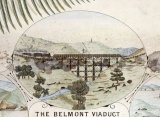 3 November 1886Manawatū rail link opened
3 November 1886Manawatū rail link openedBuilt by the privately owned Wellington and Manawatu Railway Company (WMR), the line helped open the Kāpiti Coast, Horowhenua and Manawatū to European settlement. Read more...
-
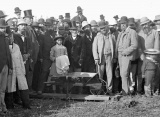 15 April 1885First sod turned for North Island main trunk line
15 April 1885First sod turned for North Island main trunk linePoliticians and Māori leaders ceremonially turned the ‘first sod’ of the central section of the main trunk line – a project that would take 23 years to complete. Read more...
-
 11 September 1880Rail tragedy on the Remutaka incline
11 September 1880Rail tragedy on the Remutaka inclineFour children were killed and 13 adults injured when two rail carriages were blown off the tracks by severe winds on a notoriously exposed part of the Remutaka incline railway. This was the first major loss of life on New Zealand’s railways. Read more...
-
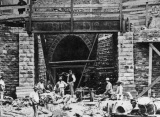 9 December 1867First passengers traverse Lyttelton rail tunnel
9 December 1867First passengers traverse Lyttelton rail tunnelAfter 6½ years of construction, it took just 6½ minutes for the first trainload of passengers to speed through the 2.6- km tunnel linking the Canterbury plains to the port of Lyttelton. Read more...
-
 5 February 1867Opening of railway from Invercargill to Bluff
5 February 1867Opening of railway from Invercargill to BluffThe 27-km line between Invercargill and Bluff was the third public railway in New Zealand. Southland's railway ambitions helped drive the province into bankruptcy. Read more...
Articles
The North Island main trunk line
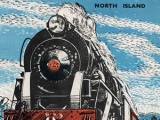
All aboard! The North Island main trunk railway was 100 years old in 2008. Take a trip back in time to explore the epic story of its construction, the heyday of the steam passenger train and the place of the iconic railway refreshment room in New Zealand life.
-
Page 2 – Building the main trunk
On 15 April 1885 Premier Robert Stout, Wahanui Huatare and Rewi Maniapoto ceremonially turned the ‘first sod' of the central section at Puniu, near Te Awamutu.
-
Page 3 – Rise and fall
A history of the North Island railway main trunk line since the first through train left Wellington on 7 August 1908
-
Page 4 – Travelling by train
For most second-class travellers, travelling the main trunk meant a long, sleepless journey on hard-backed seats, struggling to find 'elusive comfort with the NZR pillow'.
-
Page 5 – Refreshments
Refreshments are an essential and often talked about part of any train journey.
New Zealand disasters timeline
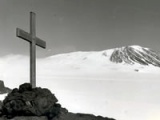
The disasters timeline and map give an overview of New Zealand's worst natural disasters, transport accidents, fires, mining accidents and other tragedies that have caused major loss of life.
- Page 1 - New Zealand disasters timelineThe disasters timeline and map give an overview of New Zealand's worst natural disasters, transport accidents, fires, mining accidents and other tragedies that have caused major
Railway stations
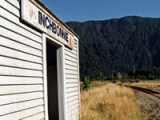
Before most people had cars or telephones, let alone television and the Internet, the railway provided many communities with their main connection to the outside world.
-
Page 2 – A community hub
In the heyday of rail travel the station was a vibrant hub of community life.
-
Page 4 – The dark side
Like other public facilities, railway stations often attracted loafers and drunks, bored teenagers or lonely souls seeking human contact.
-
Page 5 – The changing rail landscape
Today fewer than 100 railway stations survive, and only about 40 wooden stations remain on their original sites.
Cook Strait rail ferries

On a fine, calm day ‘Cruising on the Interislander’ can be like a luxury Mediterranean cruise. But on a bad day Cook Strait can be one of the world's roughest stretches of water: seasickness, dodgy food and wildcat strikes have all been part of the colourful Cook Strait ferry story.
-
Page 2 – 'The floating bridge'
Before 1962 rail struggled to compete with ships for inter-island business, but the road/rail ferries changed that.
-
Page 3 – 'An array of awful pies'
In the 1960s, the ferries' food and services fell short of the glossy ads, but now they are more upmarket.
-
Page 4 – Rough crossings
Crossing Cook Strait is often idyllic, but it can be one of the world’s roughest stretches of water as it's part of the westerly wind belt known as the Roaring Forties
-
Page 6 – Strikes and strandings
Cook Strait ferries were vital to the flow of freight and passengers between the North and South islands, and interruptions because of bad weather, mechanical problems
-
Page 7 – Fast ferries on Cook Strait
The old fable about the tortoise and the hare was replayed on Cook Strait as fast ferries offered travellers a quick dash across the ditch.
Rail tourism
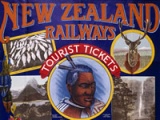
From the late 19th century the expanding rail network opened up exciting leisure and tourism opportunities for ordinary New Zealand families. New Zealand Railways promoted rail holidays through bright, attractive posters and its own popular monthly magazine.
-
Page 2 – Day excursions
From the early days of rail, excursion and special trains gave people new opportunities to visit beaches, lakes, parks, racecourses and shows.
-
Page 3 – Holidaymakers
As well as day excursions, from the mid-1890s New Zealand Railways offered special deals for travellers taking longer rail journeys over the Christmas and Easter holiday
-
Page 4 – Railways Studios
In 1920 New Zealand Railways established it own Railways Studios – the country’s first outdoor advertising studio. The studios produced posters, pamphlets, maps and
-
Page 5 – Railways Magazine
During the inter-war years no other monthly magazine matched New Zealand Railways for its commitment to promoting a popular literary culture in New Zealand.
-
Page 6 – Post-war changes
After the peak years of the 1920s and late 1930s, tourist travel all but ceased during the Second World War.
Tangiwai disaster
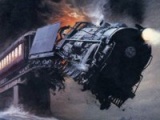
New Zealand's worst railway disaster occurred 60 years ago on Christmas Eve 1953, when the Wellington–Auckland night express plunged into the swollen Whangaehu River near Tangiwai. Of the 285 people on board, 151 were killed. The tragedy stunned the world and left a nation in mourning.
-
Page 2 – Wrong place at the wrong time
The unfortunate sequence of events that led to the Tangiwai disaster
-
Page 3 – Search and rescue
How locals and police responded to New Zealand's worst railway disaster
-
Page 5 – Death at Tangiwai: a class affair
Survival at Tangiwai depended on which class of carriage you were travelling in.
-
Page 6 – Further information
Recommended links and books relating to the Tangiwai Disaster
The Vogel era

In 1870, Colonial Treasurer Julius Vogel launched the most ambitious development programme in New Zealand’s history. The ‘Vogel era’ was a decisive moment in New Zealand’s 19th-century transformation from a Māori world to a Pākehā one.
-
Page 2 – New Zealand in 1870
Three decades after the signing of the Treaty of Waitangi, New Zealand’s two main islands were like two different countries.
-
Page 3 – Vogel's vision
In June 1870, Vogel unveiled the most ambitious public works and assisted-immigration programme in New Zealand’s history.
-
Page 4 – Building Vogel's railways
Julius Vogel wasn’t the first colonial politician to promise to fund public works and immigration with borrowed money. But the early 1870s offered better prospects for success
-
Page 5 – Vogel's legacy
After the initial enthusiasm of the 1870s, Julius Vogel’s reputation suffered in the 1880s when New Zealand’s economy slumped into a long depression that was triggered by an
NZ Railways at war

The railway system and its workforce was one of the most valuable assets available to the New Zealand state to support the national effort during the First World War
-
Page 2 – Railways in the First World War
The steam railway was a driving force of the industrial revolution and European imperialist expansion
-
Page 3 – NZ Railways in 1914
On the other side of the world, New Zealand’s rail network was a small link in the vast wartime supply chain
-
Page 4 – Railwaymen in the NZEF
More than 5000 permanent NZR employees served overseas during the war, about 40% of the 1914 workforce
-
Page 5 – Manpower challenges at home
How did New Zealand Railways (NZR) keep up its massive manpower commitments during the First World War, while still maintaining services to its customers?
-
Page 6 – Railways war memorials
Railway workers honoured the service and sacrifice of their colleagues in numerous ways.
-
Page 7 – Further information
This web feature was written by Neill Atkinson and produced by the NZHistory team. Primary sources5th New Zealand Light Railway Operating Company - War Diary, 5 February 1917
Māori King movement - 1860-94
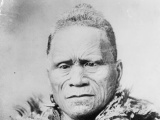
King Tāwhiao's reign was dominated by the Waikato War and the fallout from it.
- Page 6 - Tensions easeIt was clear by the 1870s that the Kīngitanga could no longer fight a war. Attempts were made to ease relations between the king and the colonial
State housing

New Zealand's first state house was formally opened on 18 September 1937. But the government has provided rental housing for New Zealanders for more than a century. Explore the history of this country's various state housing schemes and their contribution to the New Zealand way of life.
- Page 8 - Outside the mainstreamMany of us associate the beginning of state housing with the hipped-roof cottages built by the first Labour government of the 1930s and '40s. But the origin of state housing has
The 1920s

The 1920s was the decade that modern New Zealand came of age. Despite political and economic uncertainty, the country shrugged off the gloom of war to embrace the Jazz Age - an era of speed, power and glamour. Explore an overview of the decade and a year-by-year breakdown of key events.
-
Page 7 – 1924 - key events
A selection of key New Zealand events from 1924
First World War memorials
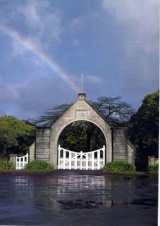
The New Zealand war memorials of the First World War have become part of the common fabric of our lives, like stop signs or lamp-posts. Virtually every township in the country has one, usually in the main street.
- Page 2 - Remembering the dead430 war cemeteries in Northern France, Belgium and the UK and more than 500 public memorials in New Zealand serve as permanent reminders of the terrible toll of the First World
Specialist Units of the NZEF
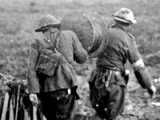
Overview of the role of Specialist Units in the First World War
- Page 8 - Railway companiesThe role and organisation of the New Zealand Railway Company and Light Railway Operating Company during the First World
Dominion status

On 26 September 1907 the colony of New Zealand ceased to exist. It became, instead, a dominion within the British Empire.
- Page 6 - New Zealand in 1907What was New Zealand like when it became a
Rolls of honour and obituaries
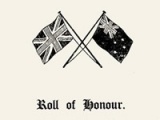
Government rolls of honour and obituaries published at the end of the First World War.
-
Page 6 – Railway workers' obituaries
Obituaries were published during the First World War in the New Zealand Railway Review,
Seddonville

The West Coast coalmining settlement of Seddonville, 50 kms north of Westport, was named in honour of the Liberal Premier Richard Seddon. It was also the site of an early experiment in state socialism – New Zealand's first state coal mine opened there in 1903.
- Page 7 - Seddonville's rail heritageThe Ngakawau-Seddonville branch line was built solely for the transport of coal from mines near Seddonville to Westport harbour, where it was then transported around New Zealand
Related keywords
- WW1 home front
- wellington city
- public service
- petone
- gallipoli campaign
- roll of honour
- battle of the somme
- western front
- trentham
- WW1
- whangarei
- red cross
- willochra
- german samoa occupation
- whanganui city
- greymouth
- photography
- invercargill
- insignia
- memorials
- railway stations
- influenza pandemic
- prisoners of war
- trade unions
- addington
- trains
- stamps
- helensville
- light railways unit
- nzef units
- health
- christchurch
- dunedin
- passchendaele offensive
- holidays
- tourism
- temuka
- timaru
- transport
- public works
- otahuhu
- mosgiel
- pioneer battalion
- tangiwai disaster
- police
- disasters
- tunnelling
- palestine campaign
- sinai campaign
- advertising
- poster
- julius vogel
- economy
- communications
- assisted immigration
- immigration
- maori land
- container shipping
- tangiwai
- bridges
- seddonville
- coal mining
- hyde
- telegraph
- provinces
- land confiscation
- lyttelton
- famous firsts
- adolescents
- rewi maniapoto
- robert stout
- wahanui huatare
- cook strait
- ferries
- strikes
- painting
- publishing
- writing
- james cowan
- robin hyde
- literature
- labour day
- parades
- joseph ward
- historic places
- race relations
- paekakariki
- food
- overlander
- refreshments
- taumarunui
- drink
- 1950s
- rimutaka
- peace celebrations
- 1920s
- Ōtira
- sport
- dominion day
- school journal
- dominion of new zealand
- shannon
- war objects
- george vance shannon
- ngati maniapoto
- otaihanga
- levin
- johnsonville
- dan sullivan
- thomas hislop
- armistice
- gore
- radio broadcasts
- bluff
- paremata
- camel corps
- great white fleet
- workers rights
- sling camp
- united kingdom
- children
- taihape
- centennial
- centennial exhibition
- MPs
- raurimu
- gold
- new zealand wars
- shipping
- rotorua
- commonwealth war graves commission
- war memorials
- belgium
- casualties
- national park
- housing
- state housing
- maori housing
- rural
- liberal party
- frankton
- public holidays
- picnics
- king country
- tahupotiki wiremu ratana
- all blacks
- tongariro
- crime
- child welfare
- katherine mansfield
- maori leaders
- kingitanga
- tukaroto potatau matutaera tawhiao
- queen victoria
- ngaio
- architecture
- fashion
- christmas
- moustaches
- kingston
- sidney holland
- prime ministers
- waiouru
- music
- songs
- music month
- death
- maps
- floods
- air transport
- erebus disaster
- wahine disaster
- CEISMIC
- timeline
- hawkes bay earthquake
-
Main image: Petone railway workers parade, 1914

